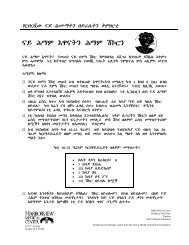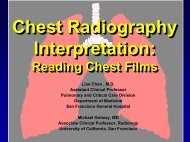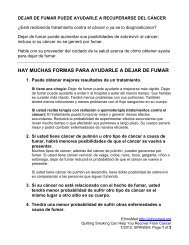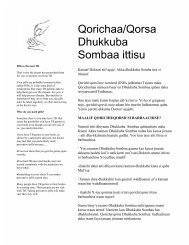Somali Knowledge Attitude Practices Study (KAPS) - EthnoMed
Somali Knowledge Attitude Practices Study (KAPS) - EthnoMed
Somali Knowledge Attitude Practices Study (KAPS) - EthnoMed
You also want an ePaper? Increase the reach of your titles
YUMPU automatically turns print PDFs into web optimized ePapers that Google loves.
Stomach-ache was also noted as a major concern of ill health in infants during the first 3 days of<br />
life in all livelihood zones and was associated with the safety of water and sugar that children are<br />
fed on soon after birth as well as ignorance on infant feeding.<br />
Data from all livelihood zones also indicated that measles, intestinal parasites and skin infections,<br />
common cold and malnutrition were also reported to be common among children from six months<br />
of age. Whooping cough was also reported in some parts of Southern <strong>Somali</strong>a.<br />
Reported Causes of Diseases in South Central <strong>Somali</strong>a<br />
Poor hygiene and sanitation, contaminated water and mosquitoes were the three major causes of<br />
diseases in South Central <strong>Somali</strong>a as reported by participants in this study.<br />
Frequent episodes of diarrhoea, intestinal worms and skin infections were attributed to poor<br />
hygiene and sanitation, indiscriminate disposal of faecal matter, flooding as well as use of<br />
contaminated water and food. Mosquito bites and stagnant water which encouraged mosquito<br />
breeding were reported to be the main cause of malaria, particularly during and following the<br />
rainy seasons. The major reported causes of diseases in different livelihood zones in SCZ are as<br />
shown on Table 5.<br />
Table 5: Reported Causes of diseases by livelihood zone in SCZ<br />
Reported Cause of Diseases Proportions (%) of Reported causes of Diseases by Livelihood Zones<br />
Pastoral (n*=51) Agro-pastoral (n=46) Riverine (n=37)<br />
Poor Hygiene & Sanitation 31 41 16<br />
Weather Condition 8 17 5<br />
Inadequate Food 2 4 8<br />
Air Born/Virus 8 7 14<br />
Contaminated Water & Food 15 7 10<br />
Mosquitoes 20 17 24<br />
Others (Cow milk, lack of 4 - 11<br />
breastfeeding Common Cold)<br />
Unknown Cause 8 7 3<br />
*n =is the total number of times all causes of disease across all age-groups within a particular<br />
livelihood zone were mentioned by respondents.<br />
Among the pastoralists, the cause of diarrhoea during hot seasons, for example, in Gedo Region,<br />
is believed to be consumption of sorghum, cow’s milk and mutton; hence children are prohibited<br />
from consuming these foods in hot seasons.<br />
Data from all livelihood zones indicated that all types of illnesses which are not well understood,<br />
including strong malaria, are believed to be caused by the evil eye (Wal koraad).<br />
According to respondents from the pastoral communities, stomach ache experienced by children<br />
during the first 3 days of life was believed to be caused by the water and sugar mixture that<br />
children are fed on soon after birth. Mothers therefore tend to withdraw use of water and sugar<br />
feeds as soon as they notice that the child might be suffering from stomach ache. In urban areas,<br />
29






